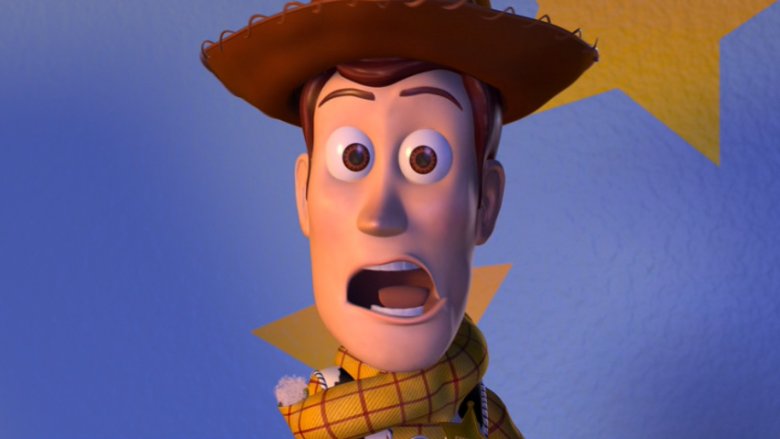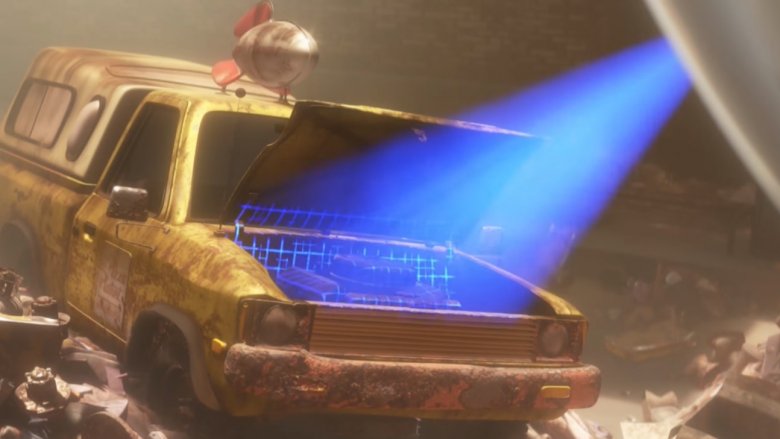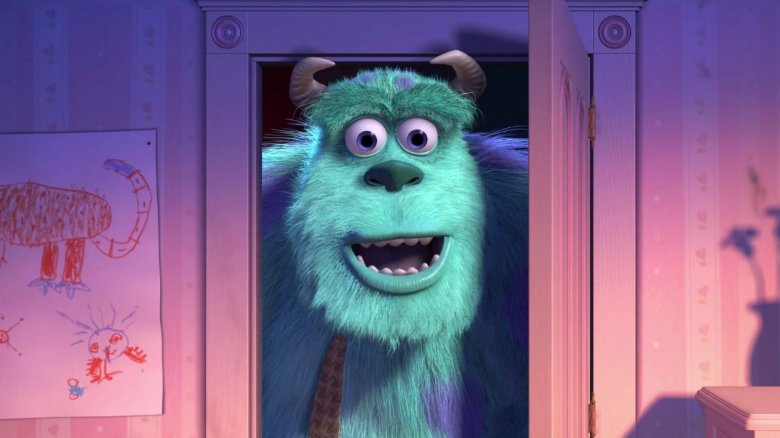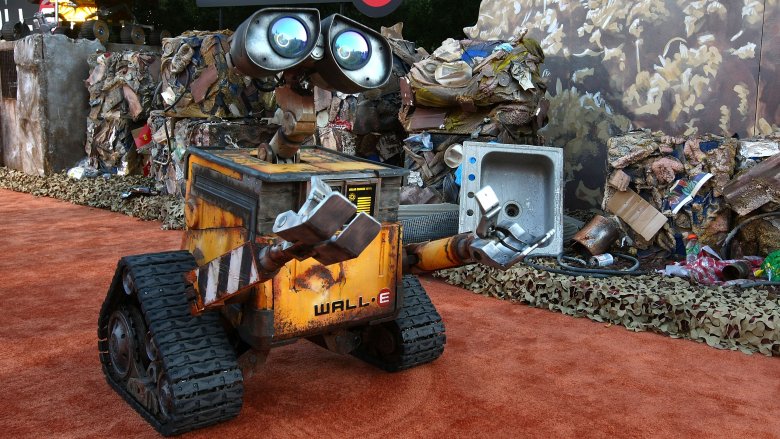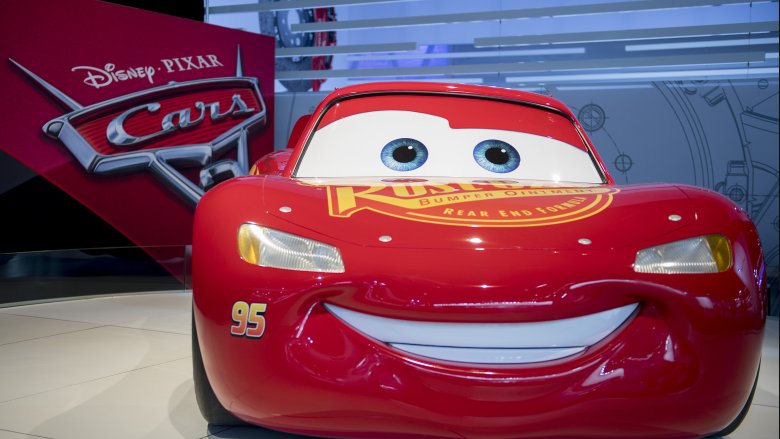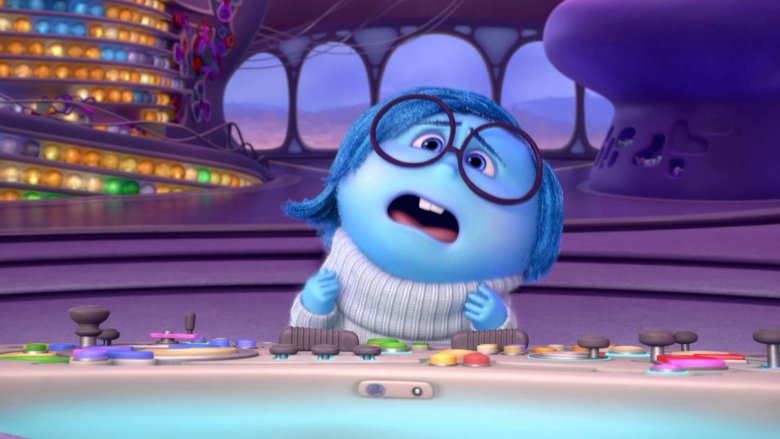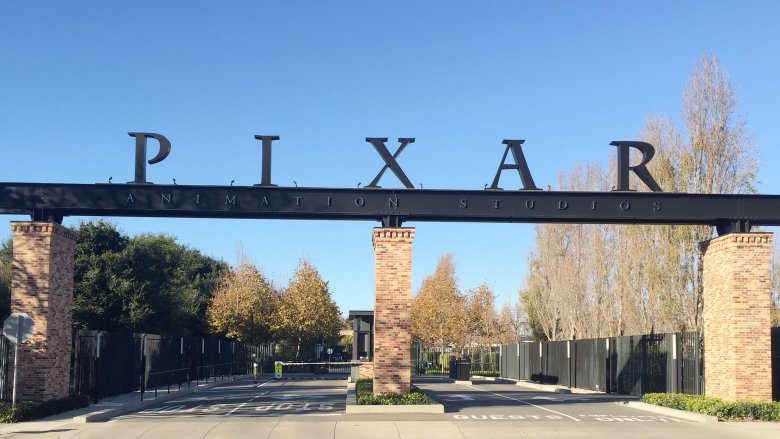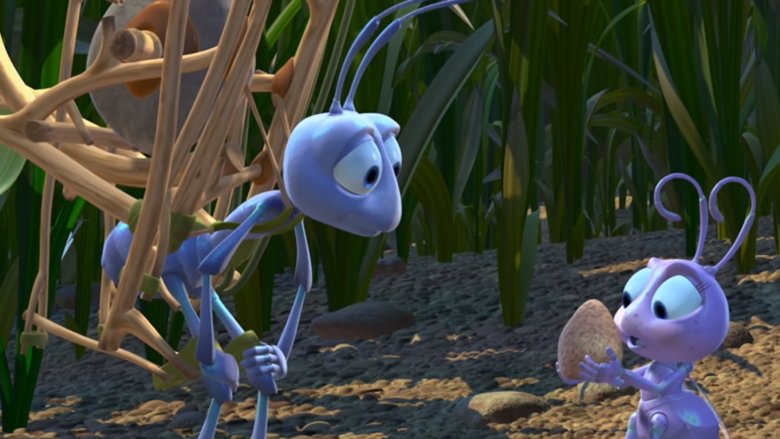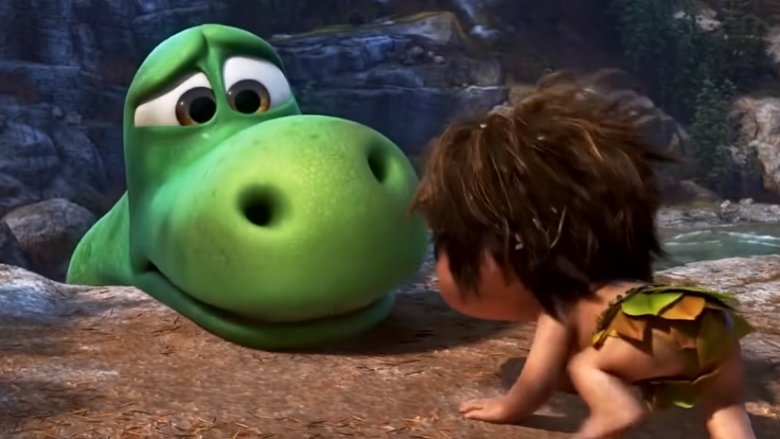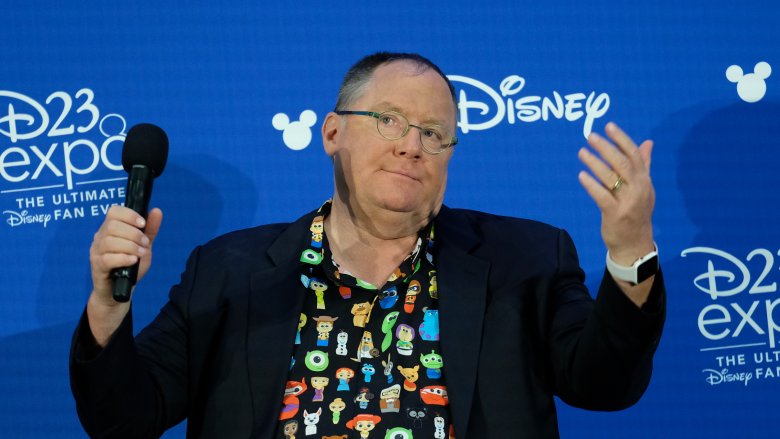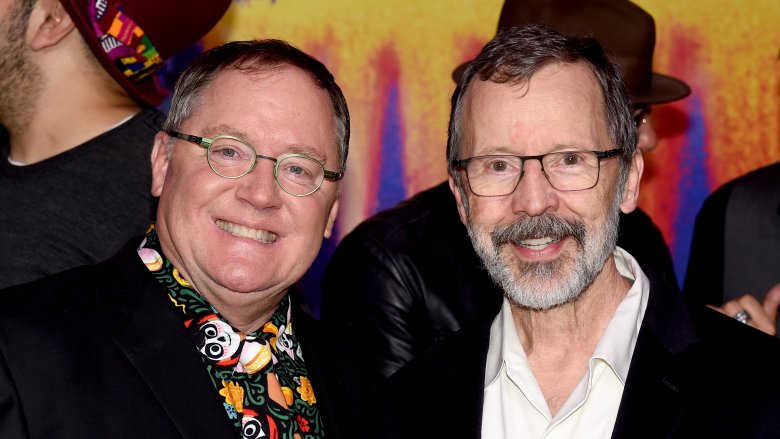False Facts About Pixar You Thought Were True
Everyone loves Pixar. For the most part, the studio has been a bastion of clever, original, emotionally affecting storytelling and technological wonderment ever since that cute little desk lamp first hopped across our screens two decades ago. Adults and children alike have been spellbound by the studio's output — not to mention usually reduced to gross blubbering messes by the third act — and the quality has rarely waned. All this while enjoying the kind of box office success and Oscar glory that makes competing studios drool like a Parisian rat preparing a gourmet meal from beneath a chef's hat.
But the story of Pixar's inception, its journey, and all the associated bits of trivia have been the source of much curiosity and intrigue over the years and, naturally, misconceptions and misquotes and outright falsehood abound. A lot of the interesting facts cited about Pixar and its films aren't actually facts at all.
The Pizza Planet truck appears in every movie
Pixar has mastered the art of the Easter egg. Subtle references and nods to previous films — as well as those yet to come — have become their bread and butter, and they pepper them in just as expertly as they elicit ugly sobs from grown men and women. And there's one thing in particular eagle-eyed viewers have come to expect every time around; the Pizza Planet truck from Toy Story.
The truck played a key role in that movie, but all subsequent appearances have amounted to blink-and-you'll-miss-it cameos. They've been impressively consistent and unobtrusive, even Brave and The Good Dinosaur have squeezed the truck in somewhere. But despite what many claim, it's nowhere to be seen in 2004's The Incredibles. Speaking to Huffington Post about it in 2015, director Brad Bird said it wasn't really on his mind at the time (he was too busy "making the movie") and he had no idea whether a cheeky animator had managed to sneak it in.
So far no one has caught it, and so the pizza delivery needs of the Parr family and their neighbors are being woefully unmet for all we know. It is in the video game, though, and by the time the sequel rolled around in 2018, Bird — or the aforementioned cheeky animator — came to his senses and threw in a 1950s-style Pizza Planet truck to keep everyone happy.
Every Pixar movie is connected
The interconnected universe is a popular conceit in fiction. You have your Marvels and DCs and all their derivatives. Kevin Smith did it. The Pixar Theory — the suggestion that each movie takes place in the same fictional universe and falls somewhere into a convoluted and meticulously constructed timeline — became very popular after blogger Jon Negroni laid it all out in 2013. The theory includes such bonkers claims as Boo from Monsters, Inc. being the same character as the witch in Brave, and the cars from Cars living in a near-future Earth after all the humans have left. It's not like Pixar hasn't been stoking the proverbial flames from the beginning, dropping in subtle references to other films all over each new release, and naturally the internet has continued to run with it.
Every new movie gets the same treatment as fans try to shoehorn it into the timeline somehow, while others are just content in the belief that all the movies are vaguely connected in some undefined way. But when asked about it at a 2015 press conference in the Philippines, director Pete Docter popped that balloon with one swift pinch. He said each movie takes place in its own separate world, and all the Easter eggs are just plain old Easter eggs. Pixar's Jay Ward and Mark Andrews have agreed. Any further speculation is just going to have to be done purely for the gosh-darned fun of it all.
WALL-E's environmentalist and anti-obesity messages were intentional
2008's WALL-E tells the story of a trash-compacting robot who rolls around a barren, garbage-covered Earth while obese humans idly reside in a perpetually floating orbital space station called the Axiom. The blatant environmentalist and anti-consumerist themes here aren't exactly buried, and they got a lot of attention on the film's release, but director Andrew Stanton denies this slant was ever intended.
"I don't have an ecological bone in my body" the filmmaker claimed in an interview with ComingSoon. The motivation behind depicting a desolate trash planet was purely functional and aesthetic, a means of providing an easily and instantly understandable situation for his main character. There's a bunch of trash, no one else is around to pick it up, and so WALL-E's purpose in this world is clear.
Likewise, Stanton says the depiction of obese humans in the space station wasn't so much a critique of corporatism, over-consumption, or greed as it was merely a representation of what happens to the body when it's been in space for a long time. Was he just toeing the political line and keeping politics out of it? Possibly, but it didn't really work. Most celebrated this aspect, others criticized it, but basically everyone acknowledged it was there.
The Cars movies made a lot of money
A lot of people assume the Cars movies did gangbusters at the box office, and when Mater the tow truck's gaping maw greets you on T-shirts and toys at every corner of any kid-heavy area in the country, it's not hard to see why. But as Wired's rundown of the studio's box office earnings over the years indicates, all three movies are actually on the lower end of the Pixar scale in terms of earnings, and the third was actually considered an outright flop.
The perceived success of Cars is almost entirely rooted in its merchandising dominance. The franchise has amassed over $10 billion in merchandising revenue, according to the BBC, which is around 30 times the first film's total box office gross. Cars 2 had a much bigger budget than the first, and its box office gross was only marginally higher. And it was the first Pixar film to receive mostly negative reviews, making it a critical flop if nothing else.
Then there's poor old Cars 3. It was actually greeted with a respectable critical response compared to its predecessor, and the consensus is that it boasts a lot more substance than either of the other two movies, but the numbers didn't reflect any of that. Despite the corporate behemoth the franchise became, it just went to show that kids were much more interested in hoarding Lightning McQueen toys and throwing them at restaurant staff than actually going to see the movies in theaters.
Their original ideas are all, well, original
As reboots, remakes and derivative cash grabs continue to dominate the mainstream movie-going landscape, genuinely original ideas seem to be in woefully short supply. For the most part, Pixar has been championed as a blessed anomaly in that sense, brimming with ideas and new ways of telling stories in a bloated industry increasingly devoted to doing the opposite. Not everyone would agree, however, and some of the studio's most original and inspired creations have been met with plagiarism accusations from some thoroughly peeved storytellers.
Inside Out has borne the brunt of these accusations. A number of lawsuits have been filed by disgruntled creators claiming to have come up with the idea first, including a Canadian filmmaker who made a similar short film with the same title in 2000, and a parenting and child development specialist who claimed to have pitched the same basic idea to Disney numerous times between 2005 and 2009. But Inside Out wasn't the first. A French author claimed that Pixar had stolen his idea for Finding Nemo and sued accordingly in 2003, and a U.K. screenwriter made a similar claim about Cars in 2011. There've been accusations outside the court of law, too, with plenty musing on the similarities between Toy Story and 1986's The Christmas Toy, and how Cars is almost like a beat-for-beat remake of 1991's Doc Hollywood. Nothing much has come of any of this, but it has made it tempting to put a small asterisk next to "original" when discussing Pixar's output.
It's an amazing place to work
Working at Pixar has often been portrayed as something of a dream job in the press: recreational facilities, very flexible work schedules, a collaborative environment, and plenty of positive vibes in general. There's even a hidden speakeasy bar. When can you start, you say? Well, don't start planning your move to Emeryville just yet. The company's record of employee satisfaction is less pristine that most seem to think.
Case in point: Pixar's higher-ups spearheaded an illegal industry-wide wage-fixing scheme back in the '80s, whereby the wages of animation workers were artificially capped to prevent them from seeking higher salaries at other companies. This went on for years, a number of lawsuits eventually followed, and a $100 million settlement was paid in 2017. Then, perhaps most infamously, there's the company's ugly culture of sexism and sexual harassment, which came to light in a big way when allegations of misconduct were leveled against co-founder John Lasseter in late 2017. Around the same time, Toy Story 4's original writers Rashida Jones and Will McCormack left the project due to the company's habit of undervaluing the contributions of women and minorities.
Lasseter's actions encouraged toxic behavior in other men at the studio, according to one former employee's account, and it became a company-wide issue. Even from the outside, it's not difficult to see the cracks — of Pixar's 20 films, Brave was the only one helmed by a woman (Brenda Chapman) and she was ultimately replaced by another dude. Suddenly that hidden bar doesn't sound all that great.
Antz and A Bug's Life's near-simutaneous release was a coincidence
Armageddon has Deep Impact, Dante's Peak has Volcano, The Prestige has The Illusionist. The twin film phenomenon — strikingly similar movies released around the same time — has become something of a Hollywood staple. Usually there's nothing fishy going on, but not so in the case of Pixar's A Bug's Life and DreamWorks' Antz in the summer of 1998. According to The Dissolve, these twins had an especially ugly sibling rivalry, and their near-simultaneous release actually came about as a result of a jilted ex-Disney employee's efforts to spite his former company.
Former DreamWorks CEO Jeffrey Katzenberg worked for Disney when Toy Story was in production and was a huge advocate for the film. He left Disney under poor terms before co-founding DreamWorks, but remained tight enough with Lassetter and co that they felt comfortable sharing their upcoming projects with him, including A Bug's Life. Speaking to Business Week about it in 1998, Lasseter claimed Katzenberg had stolen his pitch and used it as the basis for Antz, something Katzenberg always denied. What's undeniable, though, is he sped up the production of Antz so it beat A Bug's Life to the punch and was the first bug-based animated film the world would encounter that year. In Lasseter's words, Pixar was "cannon fodder in [Katzenberg's] fight with Disney." It didn't really pay off, ultimately — A Bug's Life is fondly remembered, while Antz is mostly known for giving children recurring nightmares with its creepy-as-hell character designs.
They can't make a flop
It feels like Pixar comfortably takes up residence at the top of the box office with each new release, enjoying a nice long spell in theaters before sauntering casually into a streaming and home video sales gold mine. Toy Story was the highest-grossing film of 1995, and 23 years later The Incredibles 2 became the highest-grossing animated film of all time in North America, according to Forbes. It's widely assumed that the studio simply can't release a financially unsuccessful film. Well, they actually have already, as it happens. Twice.
Remember The Good Dinosaur? Not many people do. Plagued by production woes, numerous delays, and a tepid critical response, it was Pixar's first proper commercial flop. Inside Out came out a few months earlier and cleaned house, so Dinosaur could essentially just be shoved aside and forgotten like the black sheep of the family while the golden child performed a flawless ballet recital to an adoring crowd of proud, preening parents. A minor bump in the road, but then Cars 3 fared almost as poorly in 2017. Pixar's name alone wasn't enough to get butts in seats and ensure box office glory, clearly, and financial success was no longer something they could count on.
Disney and Pixar have had a harmonious relationship
It's hard to imagine Pixar without Disney. That nostalgic Disney castle intro followed by the Luxo Jr. desk lamp hopping across the screen is like a comforting one-two pat on the shoulder, letting you know you're in safe hands for the next 90-odd minutes. Considering their success, it's reasonable to assume they've probably gotten along pretty well over the years. Alas, not so much. Their relationship has been fraught to say the least, defined largely by the messy clashing of Disney's commercial interests and Pixar's desire for artistic freedom.
After Toy Story's astronomical success, Pixar was able to renegotiate the initial deal with Disney to a more equitable 50/50 split of all profits. When it came time to renew the deal in 2004, Steve Jobs and Disney CEO Michael Eisner couldn't hash things out satisfactorily and the studios decided to part ways. After the unceremonious split, Disney created a division known as Circle 7 Animation (derisively referred to as "Pixaren't") to produce sequels without the involvement of Pixar.
Disney's $7.4 billion acquisition of Pixar in 2006 seemed to right these wrongs and satisfy both sides for the most part — Circle 7 was shut down and all its proposed projects abandoned, Disney Animation Studios absorbed a lot of the staff and revamped their own output, and both sides have more or less played nice ever since.
It has always been a film studio
When Pixar first started making waves in the '80s with a string of technically astounding short films, from the outside it looked like the studio had emerged almost fully formed from the chrysalis, dressed to the nines and ready to party. But before staking their claim as the most commercially and artistically fruitful film studio of its day, the company existed in a much more modest form; paying the bills and only dreaming of the success they'd soon enjoy. It'd be a few years before they could even call themselves a movie studio.
Before Pixar was Pixar, the company was affectionately known as The Graphics Group of Lucasfilm's Computer Division. Headed by the New York Institute of Technology's Ed Catmull, they developed computer technology to enhance other people's movies from 1979 to 1986 — responsible for the Genesis effect sequence in Star Trek II: The Wrath of Khan, for one. John Lassetter joined in 1984 as interface designer, and then along came some guy named Steve Jobs, recently ousted from Apple and hungry for a new venture. Jobs bought the company for $5 million in 1986 and christened it Pixar. It was still primarily a hardware company around this time, and folks were honing their craft working on short films, commercials, and TV spots before Disney came a-knocking in 1991. They struck a deal "to make and distribute at least one computer-generated animated movie" together. Infinity and beyond was waiting just around the corner.
